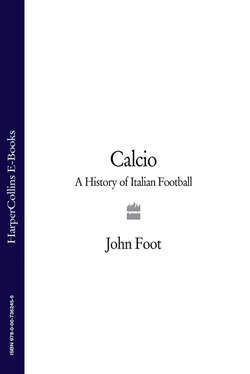Читать книгу Calcio: A History of Italian Football - John Foot - Страница 15
Calcio and World War One
ОглавлениеItaly entered the war in 1915 following a series of violent pro-war demonstrations by a radical nationalist minority. The majority of Italians were opposed to the war and millions of peasants were forced to fight in terrible conditions under officers who spoke a language – Italian – that very few of them understood. Most Italians still conversed in local dialects. Thanks largely to the collapse of the Austro-Hungarian Empire, Italy was able to force a victorious armistice in November 1918. In return for relatively tiny tracts of new land, 571,000 Italians had died and over 450,000 had been seriously wounded. War lacerated Italian society, creating divisions that were to lead to near-civil war and the destruction of her fragile democracy in the 1920s.
Instead of signalling the start of games on 23 May 1915, referees all over the country announced the suspension of the tournament. A day later, war was declared against Austria-Hungary.14 The conflict took a terrible toll on young Italian players who were called up. Virgilio Fossati, captain of Inter and the Italian national team, was killed on Christmas Day, at the age of 25. In all 26 players and staff from Inter lost their lives in the war, making their 1920 championship victory appear something of a miracle.15 Only two players played in both the 1910 and 1920 Internazionale championship teams.
During the war, Italian nationalists attempted to mobilize sport behind the war effort. Soldiers were anxious to read about sport and special sports papers were produced for them to browse through. Soldiers also played football at the front and appeals were made for footballs to be sent out to them. Sports Illustrated produced a war issue that compared the conflict to a vast game ‘in which there are no laws and the spectators are also actors’. With time, this paper became less and less about sport and more and more about war propaganda. Fascism’s use of sport as a potent propaganda weapon in the 1930s was prefigured in this period of international conflict.
Although the official championship had been called off at the start of the war, competitive football continued through a series of cup competitions. All the big teams were involved, although crowds were small, judging by the photos. Players were still being paid, much to the chagrin of the sports press, who complained that ‘nasty professionalism has still not disappeared’. There were even outbreaks of crowd trouble, ‘the usual fights’. In the reports of these games, calcio appears to be far more modern than during the ‘heroic’ phase of its growth. The players have the physical shape of modern footballers, the kit is smaller and less baggy and includes knee bandages, headbands and goalkeeping gloves. Football photographers were also improving. In the early photos, the ball was a rare sight – and papers would use crude photo montages to show ‘goals’. Now they had begun to capture goals, saves, tackles and even fights between players. Another modern development was advertising around the stadium. Football had become a business.
In 1919 the football championship began again in earnest and the sport went through a period of considerable expansion. After the war the foreign dominance on the field began to wane, although foreign players continued to arrive, whilst the technical side of the game began to be controlled by non-Italian coaches and managers. Foreign managers were brought in by most of the big clubs after the war and many enjoyed immediate success. Symbols became important as calcio invented its own history made up of a mix of tradition and myth. From the 1923–24 season onwards, the championship-winning team had a scudetto (shield) symbol – with the colours of the national flag – sewn onto their shirts. The shield-patch remained there for the whole following season, and the word scudetto began to rival that of titolo or campionato.
